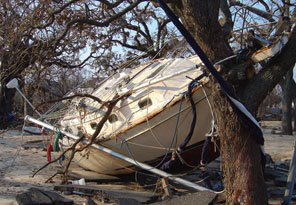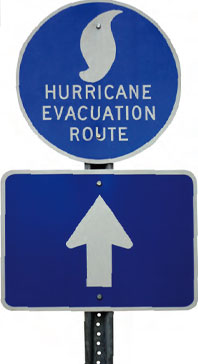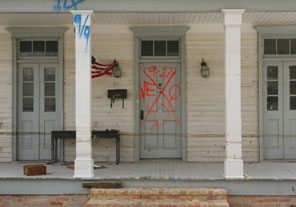Personal Reflections: Katrina, The Corps, and Change
Lieutenant General Carl A. Strock, retired, former U.S. Army Chief of Engineers and U.S. Army Corps of Engineers’ (USACE) Commander
“As a public agency the Corps of Engineers must do the right things and do things right. Where storm damage reduction in New Orleans is concerned, we did the right things as defined by Congress and the various administrations we served and as guided by public policy. Our failure was that, in hindsight, we didn’t do things right. I say ‘in hindsight’ because our engineers and decision-makers used accepted design practices that didn’t anticipate the failure mechanism involved in the collapse of the flood walls along the city’s canals. In one sense it was easy to stand up and accept accountability, because that was the right thing to do. There were certainly many mitigating circumstances that, over time, will become apparent. But, it was also very difficult because I had to publicly accept the reality that the very agency the public has relied on for over 200 years contributed to the loss of life and property — something none of my predecessors ever had to do.
“If you look at the history of the Hurricane Protection System around Lake Pontchartrain, our initial recommendation back in 1965 — to build a large surge barrier at the mouth of the lake — was challenged under an early National Environmental Policy Act (NEPA) lawsuit. And with each successive recommendation we encountered opposition and objections, so we eventually went with the current system of levees and flood walls along the lakefront and canals. One of our failures, brought out in the Interagency Performance Evaluation Task Force (IPET), was lack of recognition of the cumulative risk associated with each successive change in plans. (See this issue’s Cover Story.)
The Boiling Frogs Analogy
“One of our Southern ‘engineer philosophers’ equated our situation to boiling frogs: If you want to boil a frog, you don’t bring the pot to a boil and throw the frog in, because he’s out of there. But if you put him in a nice pot of cool water and put it on the stove and turn on the heat, it will slowly warm. And he’ll stay in the water and won’t realize he’s being boiled until it’s too late. Like the frog, we didn’t recognize the cumulative impact of the incremental decisions we made over a 40-year period. We recognized the incremental risk at each decision point, but didn’t recognize the dramatic difference between our original recommendation and the final solution. If we had said ‘go from the big barriers to I-walls,’ the shock effect would have been pretty dramatic. Someone would have likely said ‘There’s such a big difference in what you’re doing there; how could we possibly do that?’ And, we might have avoided the disastrous consequences. The other factor, also related to incrementalism, was that the project was authorized in 1965; and when the hurricane hit 40 years later, we were only 80 percent complete. And a lot of what we had done and considered finished had been overtaken by the geologic processes of subsidence and sea level change. Part of the problem was the incremental funding we received from Congress. And part of that goes back to the political process that guides Corps activities.
“That’s one of the reasons we undertook the Hurricane Protection Decision Chronology (HPDC). It’s an effort to gather all the archival information we could find about the context in which decisions were made. Our intent was not to build a justification for what we did, but rather to make the source documents and information available so that readers could draw their own conclusions from a transparent presentation of the facts. I’m convinced that those who are truly interested and take the time to study the history will discover that the Corps didn’t just get up one day and say ‘Let’s go put some levees and I-walls around New Orleans.’ I also believe the HPDC will be a resource that provides tremendous insights into public policy and decision making and will, perhaps, lead to needed reforms.
“One of the most important things in the IPET and the HPDC is the concept of risk — from the personal risk individuals face when they choose to live or to develop in an area to the public risk that must be managed by public officials. There are life-safety risks and there are economic risks; so you need to understand those. It’s clear that those risks weren’t adequately communicated to our citizens and understood or managed by many public officials. You must also understand other risks — like risks to the natural environment, especially aquatic ecosystems — when you construct a levee and change the natural flow of a river. In the Corps we really didn’t make a lot of decisions. The Corps’ role is to make recommendations to the administration and to Congress on what to do. Sometimes people made decisions that were contrary to our policies and recommendations. My mantra was to ensure that those who made the decisions, both individuals and public officials, could make informed ones by having all the information available to them in order to understand the consequences, whether positive or negative. When we’re working with public officials and say ‘These are your options and their respective pros and cons. This is our recommendation. If you don’t follow the recommendation, the alternative you favor has the following risks. Are you OK with that increased level of risk?’ It may sound like CYA, but it’s not really that. It’s about making sure that they’re making truly informed decisions and can’t come back and say ‘If only I had known, I never would have done that.’
“I’ve always believed that life is about 10 percent what happens to you and 90 percent how you respond to it. It’s disappointing to me that no other individual, group or agency that contributed to the terrible losses of Katrina said ‘We could have done things differently or better.’ Everyone else was very defensive. The Corps of Engineers was the only entity that had the courage to stand up and say ‘We got it wrong.’ The ‘Twelve Actions for Change’ (AFC) represent an institutional response that acknowledges the Corps’ need to do things differently. It was a way to say ‘We got it; we learned something here.’”
Donald Basham, retired, former Chief, Engineering and Construction, USACE Directorate of Civil Works

© iStockphoto.com/pastorscott
“It’s hard for people to understand risk; and, I think, in some cases people just take risk for granted. Having a better understanding and predictive tool out there in the future that says ‘When the storm reaches a certain category, what is the wave and surge that’s going to hit New Orleans?’ that;s what people need to understand. ‘Is that going to exceed this 17– or 25-foot levee in my backyard?’ I think that information is so critical. To say ‘There’s 27 feet of water going to hit New Orleans, and I live behind a 100-year level of protection’ really doesn’t tell anybody anything. You need to understand that’s a 17-foot high levee from sea level, and there’s 27 feet of water coming. It doesn’t take much to subtract 17 from 27 and know that 10 feet of water is coming over the top. I think you have to get it down that basic and simple so people can understand.
“Another problem is that people really are used to getting the 30-second sound byte that defines who caused the problem or what the problem is. So when you start to talk about a system of failures — that there were a whole bunch of things that contributed to this tragedy — then there are some out there that begin to think ‘Well, you’re not telling me the truth; you’re trying to cover up what really went wrong; you big-time engineers ought to be able to tell us what the real problem was here.’ And it’s more complicated than boiling it down to the 30-second sound byte to know what the real key issues were here.
“Over the years the Corps used to talk about ‘flood control;’ and then it came to realize that maybe we were part of the problem in our terminology. We’re not going to control the flood. We may reduce the damages associated with the flood by building levees and dams, which will provide some level of protection. But you’re not going to control the flood; you’re not going to control a hurricane — at least I don’t think so in the foreseeable future. We need to understand that, at the end of the day, people make their own choices. What we need to do better in the engineering and science community is to help provide better tools and techniques for them to make informed decisions. If folks want to live in New Orleans, they need to understand what level of risk is associated with the notion of living 5 feet below sea level, not even counting a hurricane. And people need to understand that even if they have FEMA insurance and federal support for the insurance program, that’s just about property. That has nothing to do with protecting people as far as health and safety; it’s not going to recover a loss of life.
“Maybe communities need to take events like disaster preparedness more seriously and conduct exercises just like they do for a fire or safety drill in their home or school. Maybe people need to question the local leadership about ‘What is the evacuation plan to get the folks who live in nursing homes to safety?’ Seventy-five percent of the people who lost their lives in New Orleans were over the age of 60 — either elderly or disabled — those least able to evacuate without assistance. How is the community going to take care of these folks? You need to have a plan to take care of these people and to get them out of harm’s way.
A Historic Body of Work
“My role in the IPET was behind-the-scenes to include advising the Chief to initiate the investigation and the search for the facts — and nothing but the facts. I formulated the overall concept and framework for the forensic investigation, which included the External Review Panel’s concurrent independent review and the selection of Drs. Link and Jaeger to lead the investigation. In addition, I led the overall effort until my retirement. For me personally, the whole IPET investigation and the external review process — the way it was all set up and the way it was conducted and went on — is probably one of the things I’m most proud of in my whole career. The study is historic; it will change the practice of engineering. I think people will stand back and say one of the greatest bodies of work that’s going to come out of this IPET investigation is the development of a risk-based methodology. . . . That’s already part of the airline and auto industries.
“I keep on going back to the simplest thing that, I think, most Americans can equate to since it’s been beaten into them over the years — the use of seat belts. You don’t reduce your potential of having an accident by putting on your seat belt; you don’t reduce your probability of having an accident by having airbags. But you do reduce the consequences of the event should it occur (i.e., loss of life and/or personal injury). That’s where we need to get to in the engineering/levee arena in helping people buy down that risk through emergency evacuation plans: making decisions to get out sooner; making sure that (when local communities have contracts with vendors) you don’t have eight parishes contract with the same bus vendor to get people out and planning ahead so, when the event occurs, people aren’t overwhelmed. Inform yourself if you live behind a levee; understand what that levee is and determine what level of protection it affords you. But, more importantly, what’s the residual risk to you, your family, your community and the place you work? Ask more informed questions. If there had been that kind of understanding for the residents of New Orleans, maybe fewer people would have lost their lives.”
Major General Don T. Riley, former USACE Director of Civil Works and now Deputy Chief of Engineers and Deputy Commanding General of the USACE

© iStockphoto.com/whirler
“I think the IPET and HPDC both reveal how complex the whole system and environment was — federal government partnered with state and local authorities, multiple agencies involved over a period of 40 years, differing levels of authorities, different projects authorized at different times, funded at different rates, authorized for different purposes and not very coherent. So when you talk about the question of blame, you have to put the blame on the system and what drove all those decisions for all the stakeholders involved. The whole system lacked synchronization, focus and discipline.
“That’s why we decided to do the HPDC. It’s been in draft form since Spring 2006; and, of course, it’s taken a long time to refine it, to put great rigor into it and to make sure that anything that’s stated in there is backed up by a document. There’s nothing in there that’s speculative; there’s nothing in there that’s innuendo. It’s all fact. . . . Looking back has been very helpful to make evident to everybody in this business how something like that could happen. But, more importantly, how do you avoid it in the future?
A Major Transformation
“In May 2006 LTG Strock released the IPET; and, at the same time, we had emerging results from the HPDC. So I went to the Chief and said ‘We need to announce what we’re going to do about the Katrina tragedy.’ I got my guys together, and we developed these ‘Twelve Actions for Change,’ which have been retitled ‘Actions for Change’ (AFC). That embarked us on a major transformation system within the Corps and an effort to transform those systems external to the Corps. We asked questions like ‘How are we going to transform not only the way we operate — our process — but also how we develop technical expertise in the Corps?’ ‘How do we tap into that expertise?’ ‘How do we transfer the great research and development we do into practical work in the field?’ ‘How do we communicate risk?’ ‘How do we take a systems approach and inform our decisions based on risk and uncertainty rather than on the old way of doing things?’
“We’re putting many of these solutions into practice now although we have a long way to go. But we’re making pretty darn good strides. We’re working with Congress to change the way we plan our projects and the kinds of recommendations we give them so they, too, can work in a more systematic way rather than on a project-by-project basis. One of our main objectives is to take a systems approach to problem-solving — phase, time and function — with all our stakeholders over time. This will begin with the planning stage all the way through design and construction, operations and maintenance. In addition, we’re now making our decisions based on an understanding of risk, and we’ve committed to communicating that risk so well that people will take personal responsibility for their own risk.”
John J. Jaeger, Ph.D., P.E. and Chief, Engineering and Construction, USACE Huntington (WV) District, Deputy Director of the IPET

© iStockphoto.com/briannolan
“We took the ‘Actions for Change’ and grouped them into four themes. Within the first theme we’re looking at a comprehensive systems approach to everything we do throughout the Corps. The second theme is we’re developing the policy, procedures and training to make more informed risk decision-making. The third theme is we’re communicating risk to the public, and the fourth theme is we’re developing professional and technical expertise. We’re looking at policy, procedures and organizational structure; behavior, technical and professional competency; and investing in our engineering and research development.
“I’m leading a national team on the professional and technical expertise. We’re taking a look at our future missions, roles and methods of delivery that we’re going to need to be great today and into the next 10 years — identifying the technical competencies that we’re going to need in the future. We’re working on items such as ‘What kind of technical competencies are we going to need for the future?’ ‘What are the best business practices for managing those competencies?’ and ‘What are the best business practices for recruiting, hiring and retaining engineers and scientists?’
“In the near future, the next couple of years or so, we have a pretty good understanding of what could be expected. That’s based on our knowledge of the past, projecting that forward. But if you start getting out more than a couple of years, as more information become available, that uncertainty becomes more prominent. . . . Time changes, and more information becomes available. For instance, climate change is a big uncertainty. Since nobody knows the future, trying to capture and deal with uncertainty is very challenging.’




























